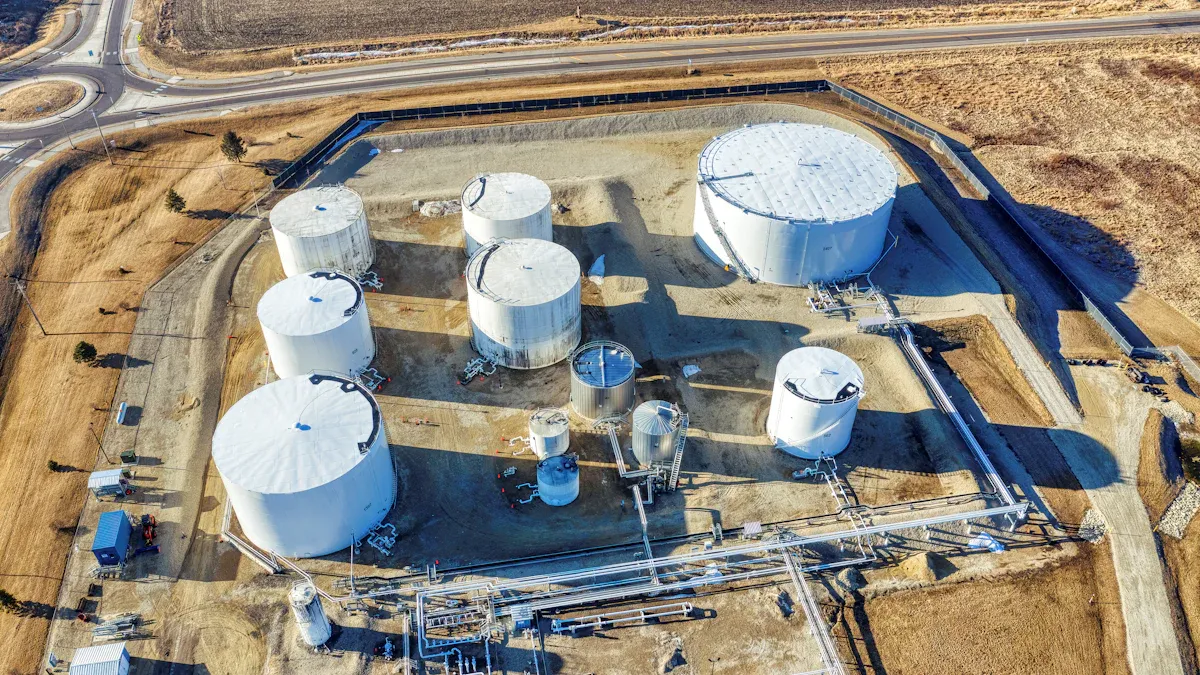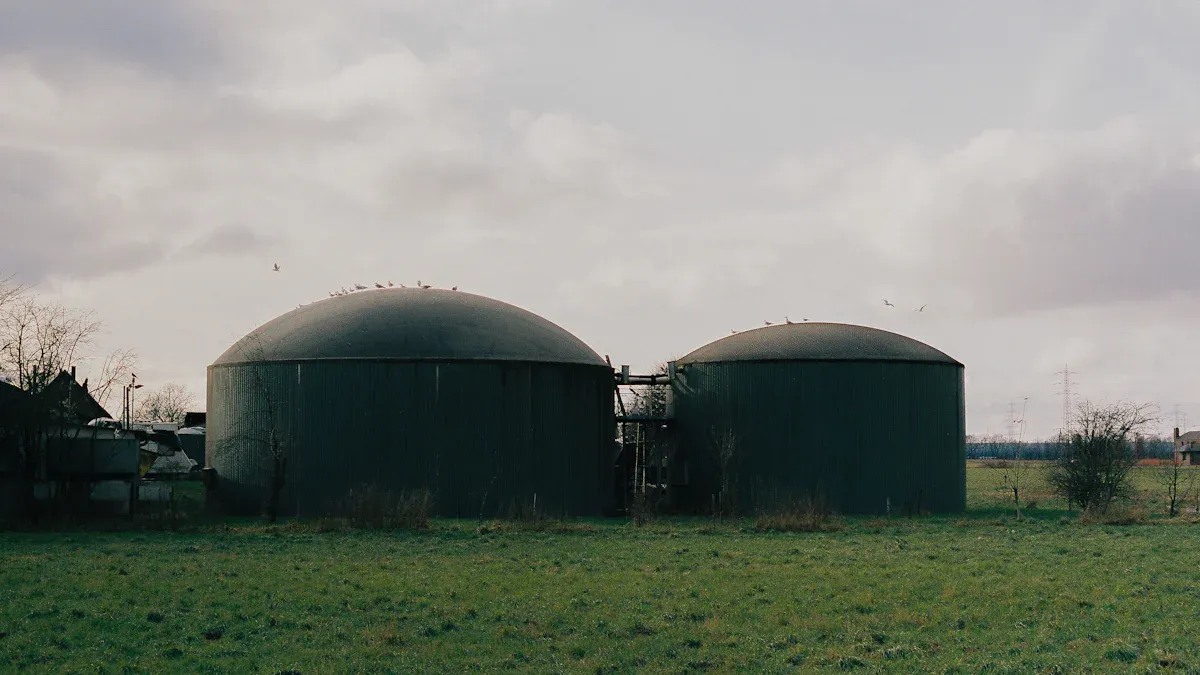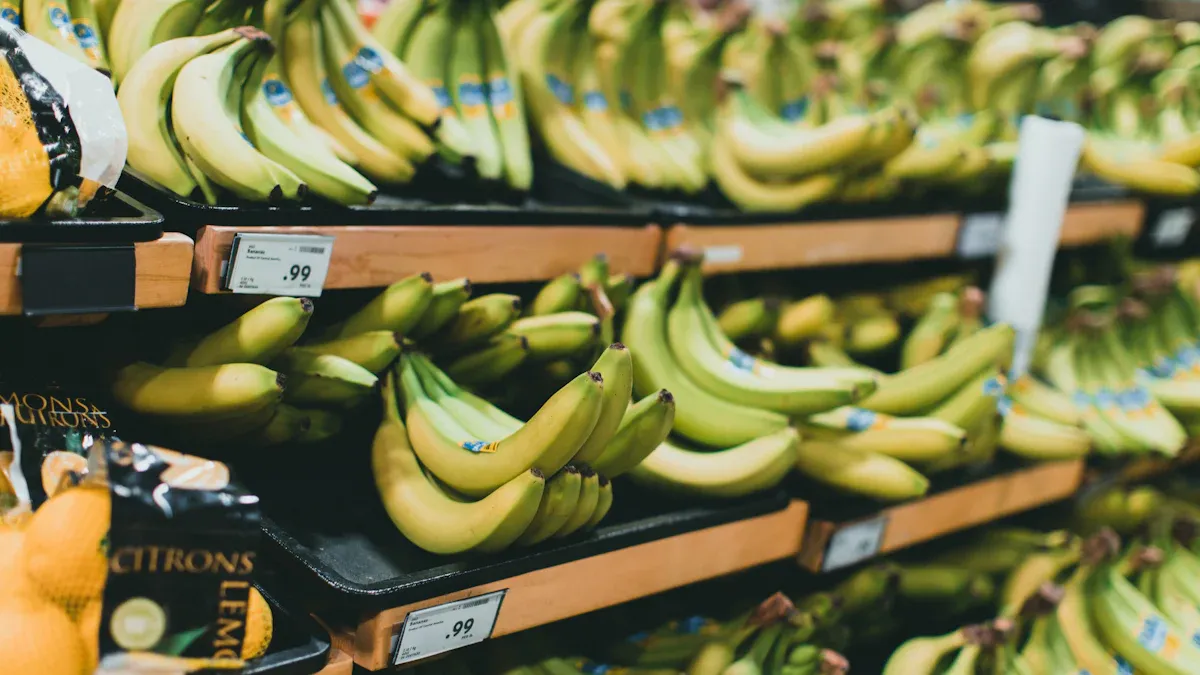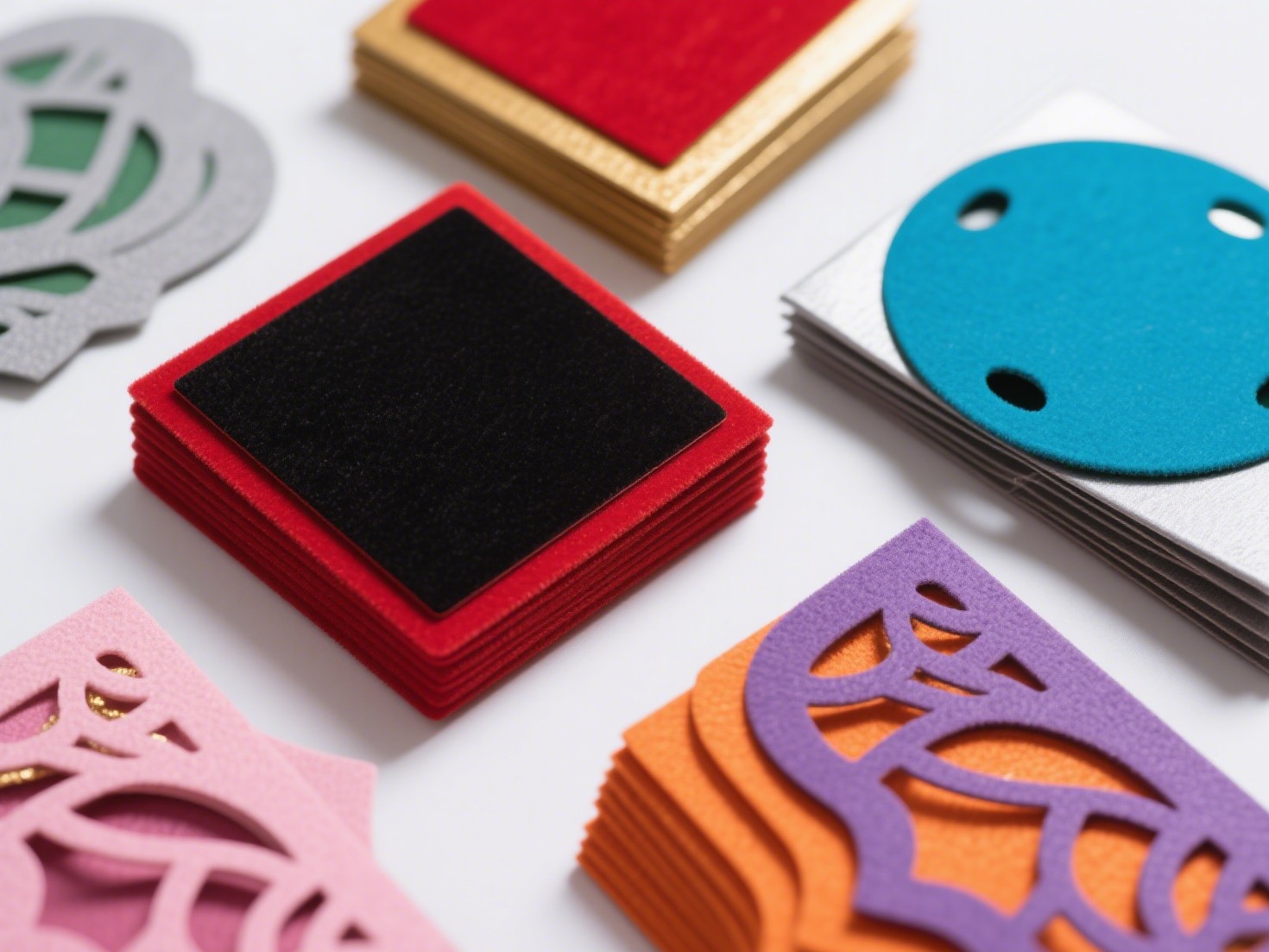
A cnc digester lets you change food and plant waste into energy. You put the waste inside the digester. The system uses anaerobic digestion to break down the waste. This makes biogas that can be used for energy. It also leaves behind good material for soil. The cnc digester is special because it works fast and makes a lot of biogas. Sensors and machines help the digester work really well.
Key Takeaways
-
A CNC digester changes food and plant waste into energy and soil. It does this with a smart process that does not use oxygen. The digester has four main steps. Microbes break down the waste. This makes methane-rich biogas. People can use this gas for cooking, heating, or making electricity. Important parts like the main chamber, feed system, mixers, heaters, and control panel all work together. They help the process stay fast and work well. Automation and real-time checks help the digester run without problems. This saves time and makes more biogas. Having a CNC digester at home cuts down on waste. It saves money and helps the environment. It makes renewable energy right at home.
CNC Digester Basics
What Is a CNC Digester?
A cnc digester is like a smart machine for waste. It changes organic waste into energy you can use. The system has controls and sensors that help it work well. You put in food scraps or plants. The digester breaks them down without any oxygen. This happens inside a closed tank. The tank keeps the right conditions for making biogas. You get energy and a safe way to get rid of waste.
Anaerobic Digestion Process
A biogas digester changes waste into energy in steps. Each step is important for making the process work well:
-
Hydrolysis: Enzymes break big pieces of waste into small ones. This helps bacteria do their job.
-
Acidolysis (Acidogenesis): Bacteria turn small pieces into acids, ammonia, and carbon dioxide. This gets the waste ready for the next step.
-
Acetogenesis: More bacteria change acids into acetic acid, carbon dioxide, and hydrogen. These are needed to make methane.
-
Methanogenesis: Methanogens turn acetic acid and other things into methane and carbon dioxide. Most of the biogas forms here.
A cnc digester mixes the waste and keeps it warm. This helps the steps work better. You get more biogas and less waste left over.
Biogas and Digestate Output
A biogas digester gives you two main things. The first is biogas, which has a lot of methane. You can use this gas for cooking, heat, or electricity. The second thing is digestate. This is what is left after making biogas. Digestate has lots of nutrients and is good for soil. Using a digester turns waste into useful things and helps the planet.
Core Components of a Biogas Digester

A biogas digester has several important parts. Each one helps you turn waste into energy and useful products. Here is a table that shows the main components and what they do:
|
Component |
What It Does |
|---|---|
|
Main Chamber |
Holds the waste and keeps out oxygen so microbes can make biogas. |
|
Feed System |
Prepares and moves waste into the digester. |
|
Mixing & Heating |
Mixes the waste and keeps it warm for better digestion. |
|
Gas Handling |
Collects, stores, and cleans the biogas for use. |
|
CNC Control Panel |
Lets you monitor and control the whole process easily. |
Main Chamber
You will find the main chamber at the heart of every digester. This chamber holds the waste and keeps it in an oxygen-free space. Microbes inside the chamber break down the waste and produce biogas. The chamber must stay sealed to keep the process safe and efficient.
Feed System
The feed system helps you add waste to the digester. It often includes a mixing tank. Here, you can mix food scraps or plant waste with water to make a smooth slurry. The system removes things that cannot break down, like plastic or metal. This step helps the digester work better and keeps the process clean.
Mixing and Heating
Mixing and heating play a big role in making biogas. The digester uses mixers to stir the waste. This helps all parts of the waste get broken down. Heaters keep the chamber at the right temperature, usually around 35°C. Warmth helps microbes work faster and make more methane.
Gas Handling Equipment
Gas handling equipment collects the biogas made in the digester. It stores the gas in special tanks. The system also filters and cleans the gas so you can use it for cooking, heating, or running a generator. Some systems connect to burners or boilers, letting you use the energy right away.
CNC Control Panel
The CNC control panel gives you control over the whole biogas digester. You can check the temperature, pH, and gas levels. The panel lets you adjust settings to keep the process running smoothly. Automation helps you get more biogas and less waste with less effort.
Tip: A cnc digester with good control and monitoring can help you make more methane and use your waste in a smart way.
How a CNC Digester Works
Feedstock Input
You start by adding organic waste into the digester. You can use food scraps, plant clippings, or even animal manure. The feed system chops and mixes the waste with water. This creates a smooth slurry that flows easily into the main chamber. You do not need to worry about large or tough pieces. The system removes anything that cannot break down, like plastic or metal. This step helps the biogas digester work without clogs or slowdowns.
Microbial Digestion
Inside the main chamber, tiny microbes get to work. They break down the waste in an oxygen-free space. You will see the process happen in four main steps. First, enzymes turn big waste pieces into smaller ones. Next, bacteria change these into acids and gases. Then, other bacteria make acetic acid and hydrogen. Finally, special microbes called methanogens create methane and carbon dioxide. This is where most of the biogas forms. The cnc digester keeps the chamber warm and mixes the slurry. This helps the microbes stay active and produce more methane.
Biogas Collection
As the microbes break down the waste, biogas bubbles up from the slurry. The digester collects this gas at the top of the chamber. Pipes move the biogas to storage tanks. You can use this gas for cooking, heating, or making electricity. Some systems connect the biogas directly to burners or boilers. Sensors track the amount and quality of the gas. You always know how much energy you have ready to use.
Tip: If you want the most biogas, keep the digester at the right temperature and feed it fresh waste often.
Sludge and Digestate Handling
After the microbes finish their job, you get two main products. The first is biogas. The second is digestate, a nutrient-rich sludge left at the bottom of the chamber. You can remove this sludge and use it as fertilizer for your garden or farm. The digester makes sure the digestate is safe and easy to handle. You turn waste into both energy and a useful soil booster.
Efficiency Factors in CNC Digesters
Automation and Control
You will notice that automation makes a CNC digester much more efficient. The system uses smart controls to manage every step. You do not have to guess when to feed the digester or adjust the temperature. The control panel lets you set the best conditions for the microbes. Automated mixers keep the waste moving, so all parts break down evenly. Heaters turn on and off at the right times. This helps you get the most biogas from your waste. You save time and avoid mistakes because the system does the hard work for you.
Tip: Automation helps you run your digester with less effort and more success.
Real-Time Monitoring
You can check what is happening inside your digester at any moment. Sensors track the temperature, pH, and gas levels. The control panel shows you these numbers in real time. If something changes, you see it right away. You can fix problems before they get big. For example, if the temperature drops, you can turn up the heater. If the pH gets too low, you can add something to balance it. Real-time monitoring helps you keep the digester safe and working well.
Here is a table showing what you can monitor and why it matters:
|
What You Monitor |
Why It Matters |
|---|---|
|
Temperature |
Keeps microbes active |
|
pH Level |
Prevents bad reactions |
|
Gas Volume |
Shows how much biogas you make |
|
Pressure |
Keeps the system safe |
Energy Optimization
You want to get the most out of your waste. The CNC digester helps you do this by using energy wisely. The system only heats the chamber when needed. Mixers run at the best times to save power. You can use the biogas right away for cooking or heating. Some systems store extra gas for later. By using energy in smart ways, you lower your costs and help the planet.
Note: Good energy management means you waste less and get more value from your digester.
Operator Tasks
Even with smart controls, you still play an important role. You check the feedstock before adding it. You make sure no plastic or metal goes into the digester. You watch the control panel for any warnings. If you see a problem, you act fast to fix it. You also clean the system and remove the digestate when needed. Your attention keeps the digester running smoothly and safely.
-
Check the feedstock for unwanted items.
-
Watch the control panel for alerts.
-
Remove digestate and clean the system.
-
Adjust settings if needed.
Remember: Your care and quick action help the digester make more biogas and work for a long time.
Benefits of a Backyard Organic Waste Digester

Renewable Energy Production
A backyard organic waste digester lets you make energy at home. You put food scraps and plant waste inside. The digester makes biogas you can use for cooking or heat. This gives you a steady supply of renewable energy. You do not have to use only electricity from the power company. Compost bins just make fertilizer, but a digester gives you energy from your waste.
Making your own biogas saves you money and means you use less fossil fuel.
Cost and Waste Reduction
A backyard organic waste digester helps you save money and cut waste. You can add food scraps, leftovers, and small yard waste. The digester breaks down waste faster than a compost bin. You do not have to wait as long for results. It also does not smell as much as regular composting. Many people see that a digester takes up less space in the yard. You do not need to buy as many trash bags or pay for extra waste pickup.
-
You send less trash to the landfill.
-
You spend less on getting rid of waste.
-
You get a cleaner and easier way to handle food waste.
Environmental Impact
You help the earth when you use a backyard organic waste digester. The system turns waste into energy and water, so you lower your carbon footprint. You do not let as much methane escape as with a compost bin. The digester works fast and keeps your yard neat and free of bad smells. Many people use digesters to reach their green goals at home.
A backyard organic waste digester helps you live greener and protect the planet.
You now know why CNC digesters work so well. Automation helps you save time and get more biogas. You turn waste into energy and useful soil products. You also help the planet by cutting down on trash and pollution.
If you want to manage waste better and make your own energy, a CNC digester gives you a smart solution. In the future, these systems will help more people live in a cleaner and greener world.
FAQ
How often should you feed a CNC digester?
You should feed your CNC digester every day or every other day. Regular feeding helps the microbes stay active and produce more biogas. Try to add similar amounts each time for the best results.
What types of waste can you put in a CNC digester?
You can add food scraps, fruit peels, vegetable trimmings, and small amounts of yard waste. Avoid adding plastic, metal, or chemicals. These items can harm the digester and slow down the process.
Does a CNC digester smell bad?
A well-maintained CNC digester does not smell bad. The closed system keeps odors inside. If you notice a strong smell, check for leaks or clogs. Proper feeding and cleaning help prevent bad odors.
How do you use the biogas from a CNC digester?
You can use the biogas for cooking, heating, or running a small generator. Some systems connect directly to stoves or boilers. Always check the gas quality before use.
What should you do if the digester stops making biogas?
First, check the temperature and pH. Make sure you feed the digester regularly. Remove any blockages in the system. If problems continue, consult the user manual or contact support for help.
https://www.schinstrument.com/how-cnc-digester-works-efficiently-organic-waste-biogas.html
www.schinstrument.com
Shenzhen Changhong Technology Co., Ltd.



+ There are no comments
Add yours